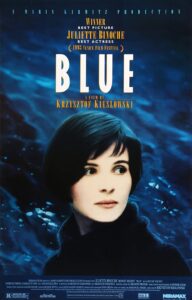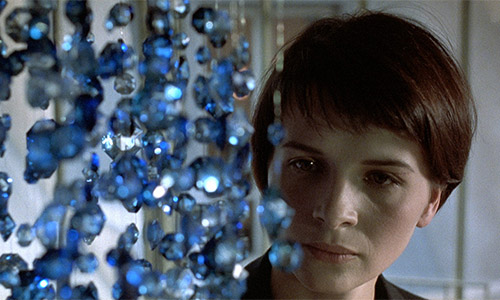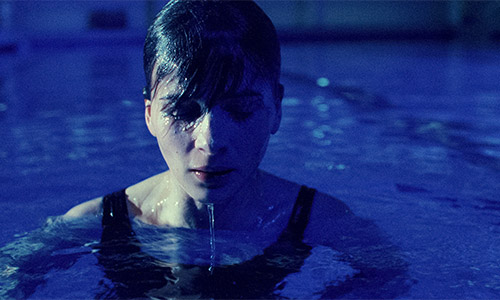 Blue is the first in Polish-born Krzysztof Kieslowski’s (The Double Life of Veronique, No End) three-part trilogy, aptly named Red, White, and Blue. While showing very little connection and not intended to be watched in any particular order, Blue (1993) had a release date before White (1994) and Red (1994). Blue also features the most recognized actor (Juliette Binoche – The English Patient, Chocolat). So, either on its own was enough to start with Blue. Together, it was a no-brainer.
Blue is the first in Polish-born Krzysztof Kieslowski’s (The Double Life of Veronique, No End) three-part trilogy, aptly named Red, White, and Blue. While showing very little connection and not intended to be watched in any particular order, Blue (1993) had a release date before White (1994) and Red (1994). Blue also features the most recognized actor (Juliette Binoche – The English Patient, Chocolat). So, either on its own was enough to start with Blue. Together, it was a no-brainer.
Blue, Red, and White are each structured around a specific theme. Red explores equality. White delves into brotherhood. Blue examines liberty. These are the three colors of the French flag and what each word represents. Kieslowski dives headfirst into each subject matter with intimate, detailed, individualized stories involving characters dealing with immense devastation and emotional adversity.
Our story in Blue is a simple one. In the film’s opening sequence, we witness a single-car accident in which Julie (Binoche) survives, but her much-beloved composer husband and young daughter are instantly killed. As she slowly regains consciousness in the hospital, her doctor tells her of the tragic news. Then, with her body in what looks like an entire cast, we painstakingly watch as Julie tries to piece together the fragmented events, her mournful face speaking volumes, as her doctor relays her the news of first her husband and then her daughter. Soon after that, with Julie still in the hospital, we watch her as she watches the funeral on her tiny cell phone, a large casket beside a small one. Julie is in the early stages of the darkest depression I could ever envision.
 Regarding the liberty theme, Julie is now free from having a past or pre-established personality. With her joy lost, she tries to commit suicide in the hospital by downing a bottle full of pills. Too scared to go through with it, Julie spits them all out. Physically, she realizes she’s not ready to give up. But, emotionally, she is spent.
Regarding the liberty theme, Julie is now free from having a past or pre-established personality. With her joy lost, she tries to commit suicide in the hospital by downing a bottle full of pills. Too scared to go through with it, Julie spits them all out. Physically, she realizes she’s not ready to give up. But, emotionally, she is spent.
At some point, she learns that her husband is having an affair. Angry and hurt, she exacts revenge by destroying all of her husband’s famous handwritten compositions, including the unfinished score of his commissioned work, to celebrate the unity of Europe following the end of the Cold War. It is hinted throughout the film that she secretly was, in some form, her husband’s ghostwriter, as writer’s block had hampered his creativity. Julie then seduces Oliver (Benoit Regent), a man who has secretly loved her for years. She beds him for a single night, leaving him longing for more. Upset and confused, she is more than aware that she has the power to do the same thing to another. Unfortunately, her night with Oliver does nothing to make her feel better but does everything to make him feel worse.
 Julie sells all her possessions, save for a single memento, a chandelier made of blue crystal beads that once hung from a lamp in her daughter’s room. Partially by her situation and choice, Julie detaches herself from relationships and memories associated with her life before the crash, all with the hope that she can discover something new to fill her heart’s void. Julie moves out of the country and finds a place in Paris, now using her maiden name, where she can become anonymously immersed in a busy city where she knows no one. While she can flee from most of her past, she continues to be haunted by the unfinished unity of her European musical composition. Initially, her inability to disconnect herself from this score hinders her from abandoning her life. But this song in her head will allow her to find peace, engage in friendships, and seek a relationship. Blue symbolizes liberty and her freedom to decide once she breaks her binding shackles. Blue is Kieslowski’s way of showcasing that to us.
Julie sells all her possessions, save for a single memento, a chandelier made of blue crystal beads that once hung from a lamp in her daughter’s room. Partially by her situation and choice, Julie detaches herself from relationships and memories associated with her life before the crash, all with the hope that she can discover something new to fill her heart’s void. Julie moves out of the country and finds a place in Paris, now using her maiden name, where she can become anonymously immersed in a busy city where she knows no one. While she can flee from most of her past, she continues to be haunted by the unfinished unity of her European musical composition. Initially, her inability to disconnect herself from this score hinders her from abandoning her life. But this song in her head will allow her to find peace, engage in friendships, and seek a relationship. Blue symbolizes liberty and her freedom to decide once she breaks her binding shackles. Blue is Kieslowski’s way of showcasing that to us.
In setting his trilogy in environments and situations that are easy for us to understand, Kieslowski enables us to encapsulate their pain, their attempts to make a semblance of tragic events, and their efforts to move forward in an unpredictable world where an event could uproot our lives in the fraction of a second. Blue brought despair to the forefront, empowering Binoche to take her character and run with it as she tried everything she could to escape her pain.
It worked.
Plot 8/10
Character Development 8/10
Character Chemistry 8.5/10
Acting 9/10
Screenplay 8/10
Directing 8/10
Cinematography 8/10
Sound 8/10
Hook and Reel 8/10
Universal Relevance 9/10
83%
Movies You Might Like If You Liked This Movie
- The Diving Bell and the Butterfly
- Rabbit Hole
- The Door in the Floor
- Three Colors: White
- Three Colors: Red